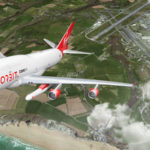John Schmidt, Accenture’s global Aerospace and Defense industry group identifies a mood of “cautious optimism” in the global consultancy’s latest report, “Preparing for Takeoff”
There’s no assurance of clear skies in 2021, but we’re seeing the commercial aerospace outlook improving as governments begin to ease travel restrictions and air travel regains momentum. According to recent Accenture analysis, industry executives are cautiously optimistic about the future. While 40 per cent still see the outlook as challenging in the next six months, half expect to see growth in the next year.
Accenture analysis, industry executives are cautiously optimistic about the future. While 40 per cent still see the outlook as challenging in the next six months, half expect to see growth in the next year.
Let’s look at how this anticipated recovery will be in different parts of the world, and the challenges that aerospace executives still need to overcome to achieve growth. A much faster recovery is expected for Asia Pacific, mostly due to domestic travel rates in China. Growth could increase as much as 9 per cent since last year.
In North America, reaching pre-pandemic levels of aircraft deliveries will likely take as long as the full airline industry recovery. We anticipate commercial aerospace will grow 16 per cent year-over-year, but demand will still be 19 per cent lower than 2019. On a positive note, activities like 737 MAX deliveries will help boost recovery, along with the American Rescue Plan Act of 2021 which includes a combined $17B for airline and aviation supplier payroll support.
Europe will witness slow recovery
Europe is witnessing a slow recovery because of extensive travel restrictions and fleet restructuring – with year-over-year growth at only 3 per cent and demand 30 per cent lower than 2019, according to our analysis. There are some bright spots, however, including the EU and UK reaching a post-Brexit trade and cooperation agreement to accept each other’s design- or manufacturing-related certificates for aircraft, parts and processes.
There are other silver linings in areas of the industry, even as wide-body deliveries are expected to decline this year and airline travel could take years to rebound. We expect narrow-body deliveries to perform the same or better in 2021, according to 83 per cent of industry executives we surveyed. Also, the temporary suspension of retaliatory tariffs by the EU and US is a positive sign.
Digital transformation investment will enable growth
In terms of setting up for growth, aerospace executives are proactively investing in digital transformation and technology. For example, nearly half the executives we surveyed said they are investing in digital collaboration tools and cloud-enabled technologies to support their remote workforces.
New technology is also being applied to areas like the supply chain, to make it smarter and more agile. The flexibility of the supply chain is vital – from the availability of critical components and parts to managing risk from the suppliers and facilities.
As more of these technologies are adopted, the aerospace industry can also be more optimistic about making sustainability attainable. The commercial sector continues to be under considerable pressure to reduce its carbon footprint and become more environmentally conscious. Not just for increasing focus on technologies such as green aircraft, hybrid propulsion and aviation biofuel, but also for how their products are being designed, manufactured and serviced. Executives told us that in three years sustainability will be as important as financial performance and customer experience, in terms of measuring and reporting.
Overall, the commercial aerospace recovery will continue to face challenges and be uneven across regions. While it is not surprising that many executives expect airline industry revenues to take years to recover to pre-pandemic levels, they are on the runway and ready for takeoff with their focus on talent, digital transformation and sustainability.

